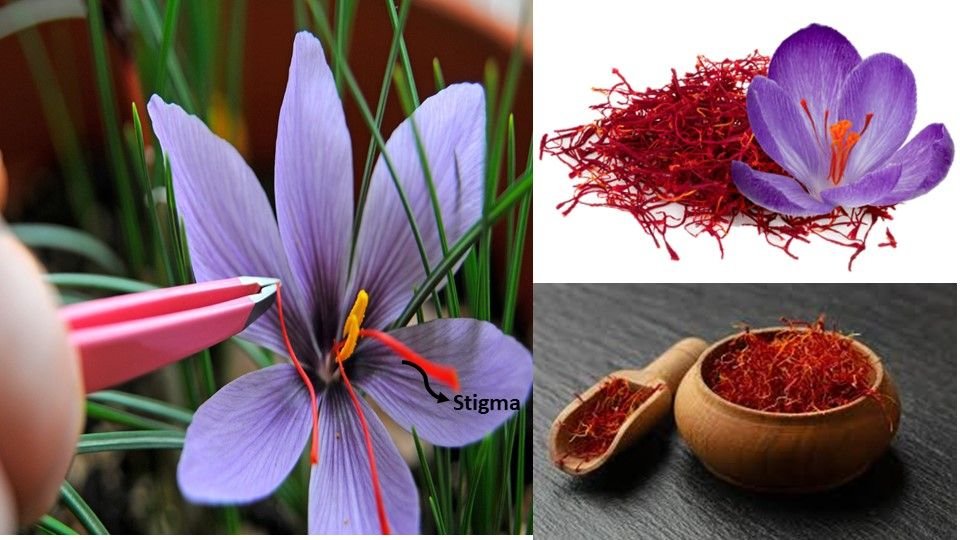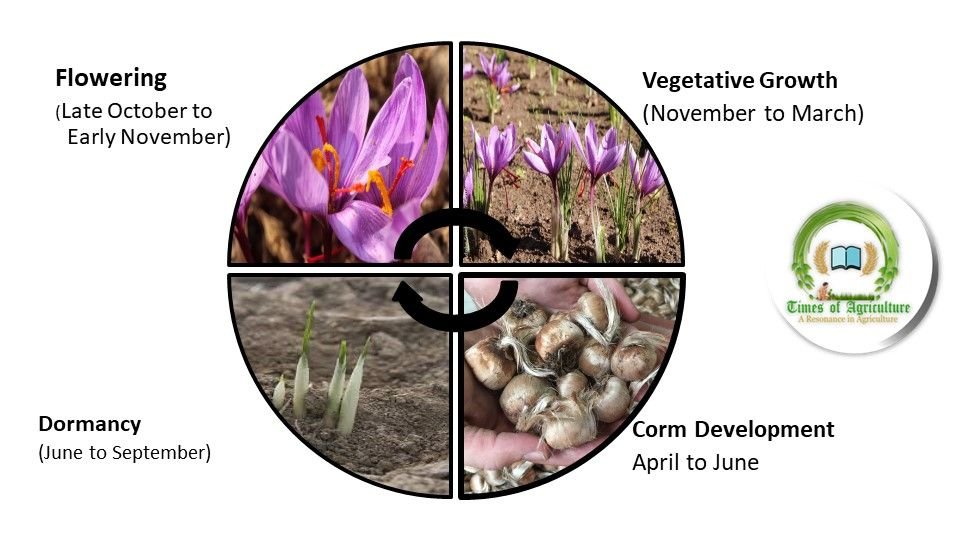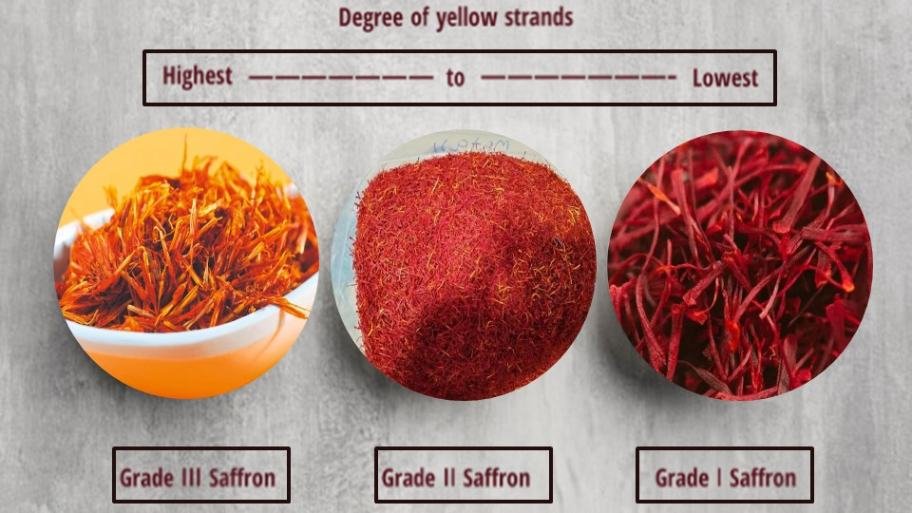Indoor cultivation of Saffron
saffron, or kesar in the common language with its bright crimson stigmas and its long history, has a unique place in both culture and food. These are common ingredients in many Indian desserts and sweets, including kulfi, ras malai, kheer and biryani, to enhance the aroma and colour. They are cherished spices and bring a premium appeal to food items. Saffron is a sign of opulence and distinction In many cultures, saffron has its own identity and distinction, and thereby it is used in ceremonies, rituals, and traditional treatments. There has recently been a spike in interest among enthusiasts in growing saffron, motivated by increasing recognition for its unique properties and a desire to feel the delight of producing this rare spice at home.
Saffron enhances the quality of natural hues, scents, and even skincare products. The trend of getting back in touch with nature and enjoying the process of growing our own food as a practical step towards a more sustainable diet and way of life is being furthered by the growing interest in saffron cultivation.
Saffron, the treasured spice produced from the Crocus sativus flower, is an exciting plant with exquisite beauty and phenomenal properties. The purple petals and red stigmas of saffron contain the key to one of the world’s most prized spices. Crocus sativus, unlike other crocuses, blooms in the autumn, producing three scarlet stigmas known as saffron threads per flower. Saffron, a spice famed for its unique flavour, perfume, and vivid golden colour, is made from these scarlet threads that are delicately hand-harvested and dried.
Moisture Management: During the germination phase, keep the soil moist but not wet. Water in moderation to avoid excessive moisture, which can cause seed rot.
Temperature Considerations: Maintain a warm atmosphere for germination, ideally between 60 and 70 degrees Fahrenheit (15 and 21 degrees Celsius). Consider using a heat pad or storing your containers in a warm, well-lit location.
Patience is essential: Be patient with the germination process, since saffron seeds might take many weeks to sprout. Check soil moisture and temperature on a regular basis to guarantee ideal conditions.
C. Germination Timeline:
Germination Timeline Variable:
- The germination timeline for saffron seeds can vary depending on factors such as temperature and soil conditions. Expect a waiting period ranging from three weeks to many months.
Maintain vigilance and observation:
- Keep a close check on the soil for the appearance of small saffron seedlings. Continue to offer optimal circumstances for the new plants to thrive after germination occurs.
- How to Grow Saffron Plant: Emerging Ones
Saffron, which is famous for its bright crimson threads and unique flavour, needs to be grown with care and love. The following steps mentioned below shows how to grow Saffron Crocus and how much time saffron takes to grow.
Obtain High-Quality Saffron Corms:
- To begin, buy high-quality saffron corms from reliable wholesalers or nurseries.
- Corms are bulb-like structures that develop into saffron crocus flowers.
Choose Well-Drained Soil:
- Saffron grows on soil that is well-drained and has a slightly alkaline pH.
- Maintain proper drainage to avoid waterlogging, which can be harmful to saffron corms.
Plant corms in late summer or early fall:
- Plant corms in late summer or early fall to give them time to grow roots before winter.
- For appropriate spacing and development, plant corms 3 to 4 inches deep and 4 to 6 inches apart.
Choose a sunny spot:
- Saffron plants thrive in full sunlight, so put them in a sunny spot.
- Make certain that the chosen location receives at least six hours of sunlight daily.
Crocus sativus variety:
- Crocus sativus, formally known as saffron crocus, is the particular cultivar sought for saffron production. Make sure you have the right kind for saffron growing.
Develop Roots Before Winter:
- Plant the corms early enough so that they can grow roots before winter arrives.
- This guarantees that the plants are well-rooted and ready for the growth season.
Ensure adequate sunshine:
- Saffron plants require enough sunshine to blossom, which is an important stage in saffron production.
- Ascertain that the chosen area receives enough sunshine for the plants to grow.
Monitor moisture levels:
- Saffron appreciates well-drained soil and is sensitive to excessive wetness.
- Water the plants sparingly, making sure the soil is continually wet but not soggy.
Patience During Growth:
- Be patient while the saffron plant grows, particularly in the first year.
- Allow the plant to establish itself before concentrating on developing robust corms for future seasons.
Harvest Saffron Threads in Late Autumn:
- Harvest the red stigmas, also known as saffron threads, during the late autumn blooming season.
- Take care not to harm the delicate saffron harvest by carefully plucking the threads from the blossoms.

Post-Harvest Care: Handling with Care
Saffron threads are so delicate in nature and precious in value; hence, they are termed golden threads. It is critical to preserve the quality of saffron throughout the harvest to ensure that it retains its distinct flavour and colour. When it is time to harvest, we must exercise caution and pluck the saffron threads delicately. This is best done early in the morning, when the blooms have just bloomed.
We pick the threads with our fingers or little tweezers, being careful not to harm them. It’s vital not to contact the saffron too much since the oils in our skin might alter its flavour. Harvesting should occur on a regular basis during the flowering season, and once harvested, we lay it out to dry in a shady, well-ventilated place. This keeps the saffron fresh and prevents it from going rancid. This will give insight into how to grow saffron crocus in a protective way.
Post Harvest Care:
| SNo. | PROCEDURES | DESCRIPTION |
| 1. | Pruning and trimming | ● After flowering, cut down the leaves to enhance nutrient storage in the corm. ● To preserve plant health, remove dead leaves and discarded blossoms. |
| 2. | Limited Watering (Dormancy) | ● Reduce watering during the dormant season, which is usually in the summer, to avoid corm rot. |
| 3. | Protecting corms (Winter) | ● Provide a layer of mulch to preserve saffron corms over the winter in colder locations. |
| 4. | Pest and Disease Control | ● Keep a watch out for pests and illnesses, particularly after harvest. |
| 5. | Divide Corms for Renewal | ● To rejuvenate the planting bed, split and replant saffron corms on a regular basis. ● This practice prevents overpopulation and encourages rapid development. |
| 6. | Nutrient-Rich Soil Amendments | ● After harvesting, improve the soil with well-rotted organic materials. ● Rich in nutrients, soil helps corms grow and gets the plants ready for the next growing season. |

Growth cycle: How much Time Saffron Takes to Grow
The output may not be at its peak in the first few years once saffron plants begin to blossom in the second or third year. Cultivating saffron takes time, and as the plants get older, they usually produce more. Do you know how many days to grow saffron?
It takes around two to three years from corm planting to the first big harvest. As long as the plants have the right maintenance and care, farmers must continue growing the same plants for a number of years in order to reach ideal saffron output.
How to Grow Saffron Commercially: Growing Saffron
If you are looking to venture into commercial saffron farming, then mark these points in mind to uncover the secrets of how to grow saffron. Careful planning and close attention are crucial to engaging in commercial saffron farming. Choose a site that has a favorable climate, well-drained soil, and water availability as your starting point. Saffron corms are frequently planted in rows during large-scale farming to maximize area and enable mechanized harvesting. Install the right irrigation systems to guarantee steady moisture without causing waterlogging. Think about working with agricultural specialists to create a thorough business strategy that addresses things like marketing and post-harvest processing. Keep these points in mind while following how to grow saffron crocus for commercial purpose.

Scaling Up Saffron Production
- Increased Planting: Plant more corms to increase the size of the saffron crop. Based on the resources at hand and the demand in the market, choose the right size.
- Optimal Field Plan: To handle a bigger saffron harvest, design an effective field plan. For efficient growing and harvesting, plan and space things out as much as possible.
- Mechanization Considerations: Look at the possibilities for mechanising chores such as planting and harvesting. Large-scale saffron cultivation may become more efficient with the use of mechanised methods.
- Technology Utilization: Use cutting-edge technology for pest control, irrigation, and monitoring. Processes may be streamlined by technology, which raises production levels overall.
Economic Considerations and Profitability
- Market Research: To comprehend saffron demand and price, conduct in-depth market research. Determine prospective purchasers and make contacts in the market.
- Cost-Benefit Analysis: Examine the costs and benefits of commercial saffron growing in great detail. Think of things like land, labour, tools, and additional running expenses.
- Product Diversification: Look at ways to expand the uses of saffron beyond spices. Think about creating products with value additions, extracts, or saffron-based items.
- Sustainable Practices: To cut expenses and win over environmentally sensitive customers, use sustainable agricultural techniques. Obtaining certification for sustainable or organic practices might improve one’s marketability.

How to Grow Saffron at Home: Step-by-step Guide
Can you even imagine how to grow saffron crocus that too at home? Yes, we can. Saffron cultivation at home is a fulfilling task. The secret is to recreate the natural environment that saffron longs for, whether you have a garden or prefer containers. Make sure the soil is properly drained, there is enough sunlight, and the corms are spaced apart. For people who have little outside space, container gardening is a great choice. To fit several corms, use large pots with a diameter of at least 12 inches. Additionally, because saffron is prone to frost, think about moving the pots indoors during really cold weather. Here, we will reveal how to grow saffron at home in your own space.
Selection and Preparation of the Container:
- To avoid waterlogging, use a container that drains well and has drainage holes.
- Choose a potting mix that has sand in it for the best drainage.
- To fit saffron bulbs, make sure the container is at least 6 inches deep.
Planting Saffron Bulbs:
- In late summer or early autumn, plant saffron bulbs, also known as corms.
- Plant the bulbs 4–6 inches apart and 3–4 inches deep.
- Place the bulbs so that their pointed ends are facing up.
Creating Ideal Growing Environments:
- Light: Saffron needs direct sunshine to thrive. The container should get at least 6 to 8 hours of direct sunshine every day in a sunny setting.
- Temperature: Keep the temperature between 15 and 21 degrees Celsius (60- and 70-degrees Fahrenheit). Growing saffron indoors is a great idea.
- Humidity: Saffron prefers low to moderate humidity.
Tips for Fertilizing and Watering:
- Watering: Apply a little mist to the saffron, making sure the soil is always damp but not soggy. Every time you irrigate the soil, let it dry out.
- Fertilizing: During the growth season, use a balanced fertilizer with a little greater potassium content. Use fertilizer moderately to prevent an overabundance of nutrient accumulation.
Controlling Possible Insects and Illnesses:
- Pest Control: Keep an eye out for typical indoor pests such as aphids and spider mites. If required, treat with insecticidal soap.
- Maintaining enough air circulation might help avoid fungal illnesses. Refrain from overwatering saffron since excessive moisture might cause corm rot.
For those without access to outdoor areas, indoor saffron farming is a great year-round option. You may take pleasure in cultivating and gathering your own saffron at home by following these instructions and giving it careful attention.
Conclusion: Rewarding Experience
The illustration covers an overview of how to grow saffron at home through an intricate process from bulb to bloom. The saffron crocus recounts a tale of tenacity, development, and the ultimate display of its highly valued saffron threads—a harvest that perfectly captures the essence of this sought-after spice—as each day passes. Looking into saffron farming, it’s essential to consider the fulfilling experience it provides. It covered the time aspect that is how much time saffron takes to grow to give a fulfilling treat. Growing saffron is an experience that links people to tradition, environment, and the skill of cultivating a valuable spice, beyond its distinctive flavour and bright threads.
